Analyzing People Practice Essentials: Work-Life Balance at Technow
VerifiedAdded on 2023/06/18
|11
|2621
|70
Report
AI Summary
This report analyzes the essentials of people practice within Technow, focusing on the importance of work-life balance, employee engagement, diversity and inclusion, and relevant legislation. It examines how achieving work-life balance positively impacts employee performance and productivity, highlighting key regulations like the Health and Safety at Work Order 1978 and the Working Time Regulations 1998. The report also discusses the significance of employee wellbeing, exploring the positive and negative aspects of employee engagement and their impact on how people feel at work. Furthermore, it summarizes key points of discrimination legislation, including direct and indirect discrimination, victimization, and harassment, and explains the differences between diversity and inclusion compared to equal opportunities. Finally, the report differentiates between fair and unfair dismissal as defined in legislation, referencing The Employment Rights Act 1996 and the Unfair Dismissal Act 1977, using a case study of Technow to illustrate these concepts.

Essentials of People Practice
TASK FOUR
1
TASK FOUR
1
Paraphrase This Document
Need a fresh take? Get an instant paraphrase of this document with our AI Paraphraser
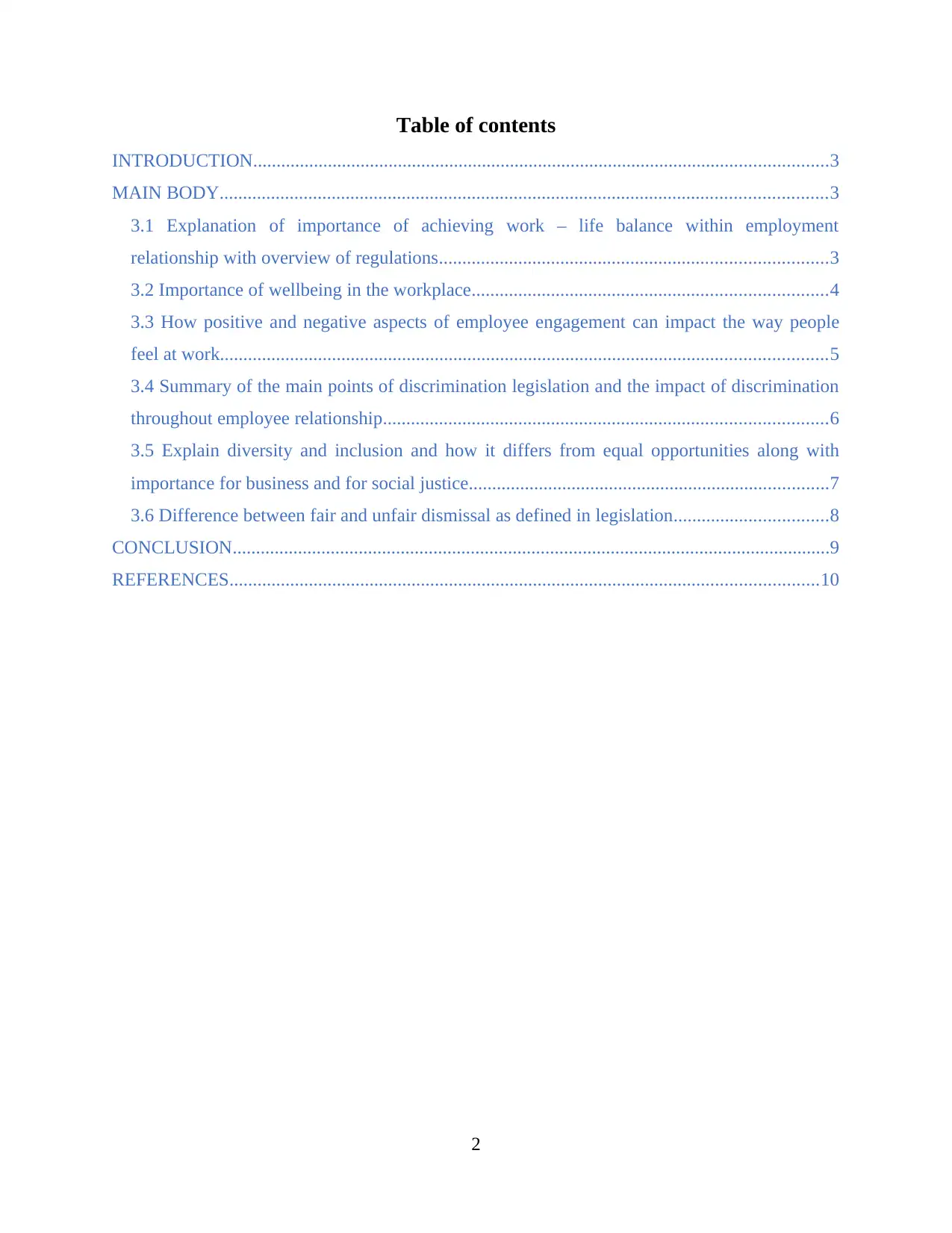
Table of contents
INTRODUCTION...........................................................................................................................3
MAIN BODY..................................................................................................................................3
3.1 Explanation of importance of achieving work – life balance within employment
relationship with overview of regulations...................................................................................3
3.2 Importance of wellbeing in the workplace............................................................................4
3.3 How positive and negative aspects of employee engagement can impact the way people
feel at work..................................................................................................................................5
3.4 Summary of the main points of discrimination legislation and the impact of discrimination
throughout employee relationship...............................................................................................6
3.5 Explain diversity and inclusion and how it differs from equal opportunities along with
importance for business and for social justice.............................................................................7
3.6 Difference between fair and unfair dismissal as defined in legislation.................................8
CONCLUSION................................................................................................................................9
REFERENCES..............................................................................................................................10
2
INTRODUCTION...........................................................................................................................3
MAIN BODY..................................................................................................................................3
3.1 Explanation of importance of achieving work – life balance within employment
relationship with overview of regulations...................................................................................3
3.2 Importance of wellbeing in the workplace............................................................................4
3.3 How positive and negative aspects of employee engagement can impact the way people
feel at work..................................................................................................................................5
3.4 Summary of the main points of discrimination legislation and the impact of discrimination
throughout employee relationship...............................................................................................6
3.5 Explain diversity and inclusion and how it differs from equal opportunities along with
importance for business and for social justice.............................................................................7
3.6 Difference between fair and unfair dismissal as defined in legislation.................................8
CONCLUSION................................................................................................................................9
REFERENCES..............................................................................................................................10
2
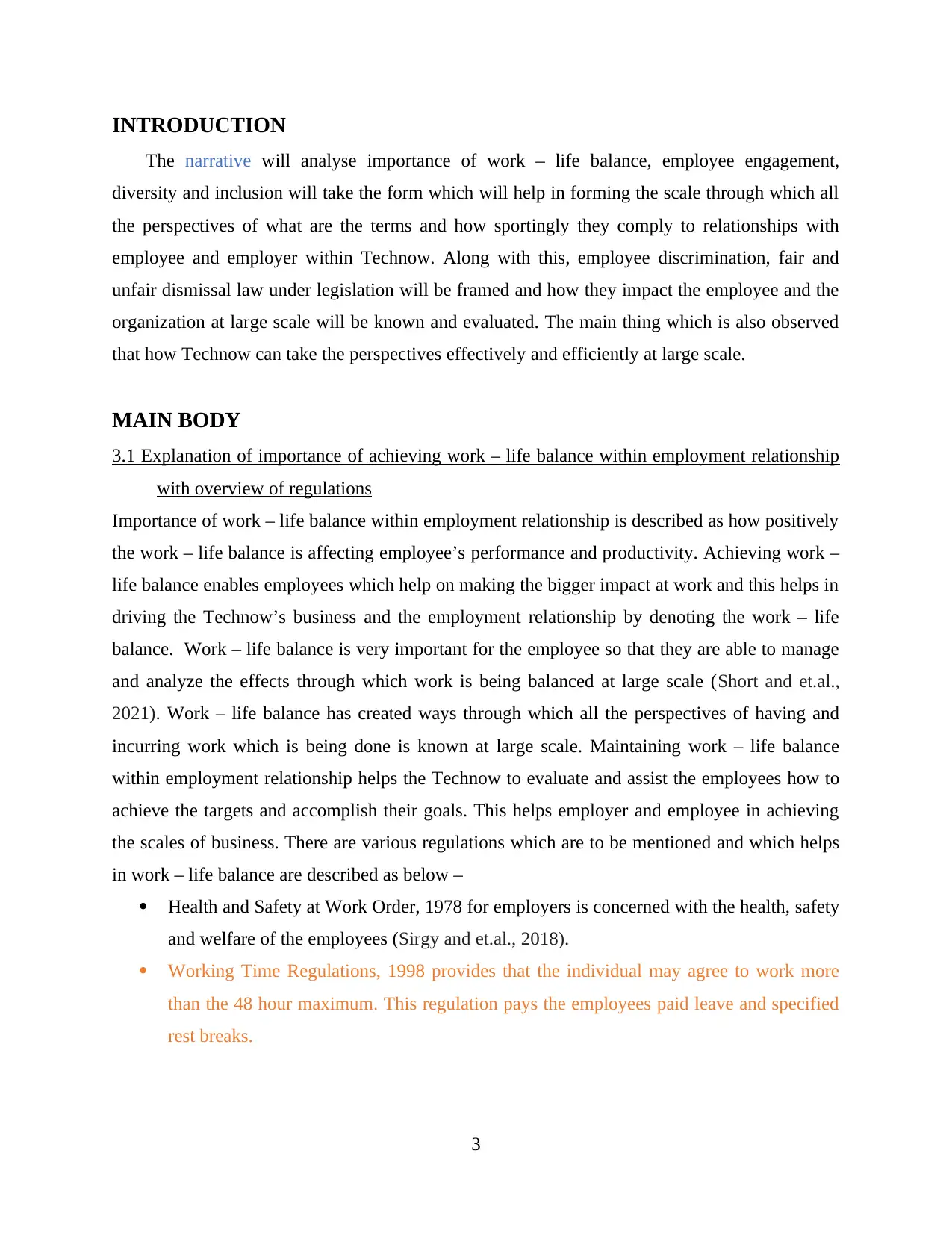
INTRODUCTION
The narrative will analyse importance of work – life balance, employee engagement,
diversity and inclusion will take the form which will help in forming the scale through which all
the perspectives of what are the terms and how sportingly they comply to relationships with
employee and employer within Technow. Along with this, employee discrimination, fair and
unfair dismissal law under legislation will be framed and how they impact the employee and the
organization at large scale will be known and evaluated. The main thing which is also observed
that how Technow can take the perspectives effectively and efficiently at large scale.
MAIN BODY
3.1 Explanation of importance of achieving work – life balance within employment relationship
with overview of regulations
Importance of work – life balance within employment relationship is described as how positively
the work – life balance is affecting employee’s performance and productivity. Achieving work –
life balance enables employees which help on making the bigger impact at work and this helps in
driving the Technow’s business and the employment relationship by denoting the work – life
balance. Work – life balance is very important for the employee so that they are able to manage
and analyze the effects through which work is being balanced at large scale (Short and et.al.,
2021). Work – life balance has created ways through which all the perspectives of having and
incurring work which is being done is known at large scale. Maintaining work – life balance
within employment relationship helps the Technow to evaluate and assist the employees how to
achieve the targets and accomplish their goals. This helps employer and employee in achieving
the scales of business. There are various regulations which are to be mentioned and which helps
in work – life balance are described as below –
Health and Safety at Work Order, 1978 for employers is concerned with the health, safety
and welfare of the employees (Sirgy and et.al., 2018).
Working Time Regulations, 1998 provides that the individual may agree to work more
than the 48 hour maximum. This regulation pays the employees paid leave and specified
rest breaks.
3
The narrative will analyse importance of work – life balance, employee engagement,
diversity and inclusion will take the form which will help in forming the scale through which all
the perspectives of what are the terms and how sportingly they comply to relationships with
employee and employer within Technow. Along with this, employee discrimination, fair and
unfair dismissal law under legislation will be framed and how they impact the employee and the
organization at large scale will be known and evaluated. The main thing which is also observed
that how Technow can take the perspectives effectively and efficiently at large scale.
MAIN BODY
3.1 Explanation of importance of achieving work – life balance within employment relationship
with overview of regulations
Importance of work – life balance within employment relationship is described as how positively
the work – life balance is affecting employee’s performance and productivity. Achieving work –
life balance enables employees which help on making the bigger impact at work and this helps in
driving the Technow’s business and the employment relationship by denoting the work – life
balance. Work – life balance is very important for the employee so that they are able to manage
and analyze the effects through which work is being balanced at large scale (Short and et.al.,
2021). Work – life balance has created ways through which all the perspectives of having and
incurring work which is being done is known at large scale. Maintaining work – life balance
within employment relationship helps the Technow to evaluate and assist the employees how to
achieve the targets and accomplish their goals. This helps employer and employee in achieving
the scales of business. There are various regulations which are to be mentioned and which helps
in work – life balance are described as below –
Health and Safety at Work Order, 1978 for employers is concerned with the health, safety
and welfare of the employees (Sirgy and et.al., 2018).
Working Time Regulations, 1998 provides that the individual may agree to work more
than the 48 hour maximum. This regulation pays the employees paid leave and specified
rest breaks.
3
⊘ This is a preview!⊘
Do you want full access?
Subscribe today to unlock all pages.

Trusted by 1+ million students worldwide
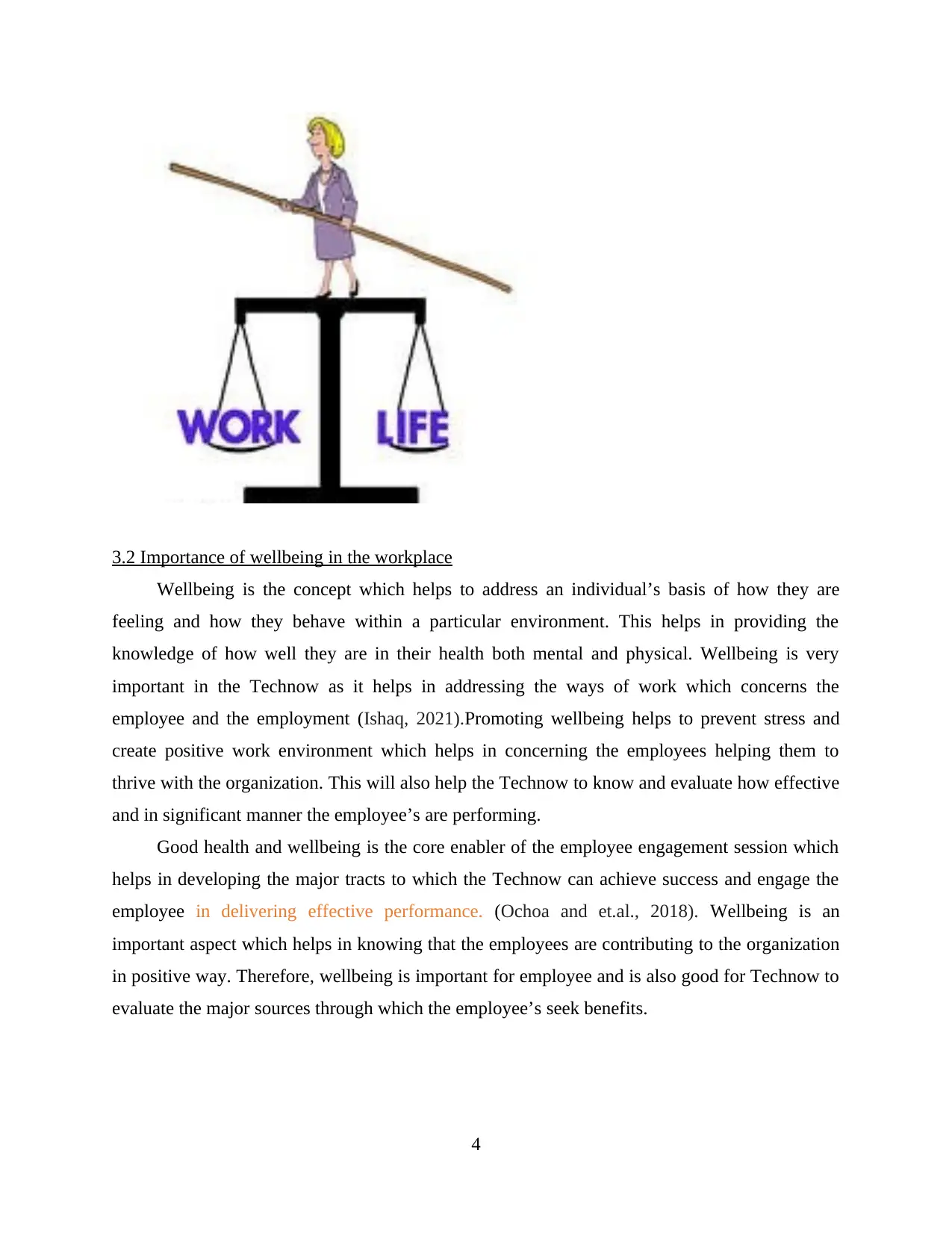
3.2 Importance of wellbeing in the workplace
Wellbeing is the concept which helps to address an individual’s basis of how they are
feeling and how they behave within a particular environment. This helps in providing the
knowledge of how well they are in their health both mental and physical. Wellbeing is very
important in the Technow as it helps in addressing the ways of work which concerns the
employee and the employment (Ishaq, 2021).Promoting wellbeing helps to prevent stress and
create positive work environment which helps in concerning the employees helping them to
thrive with the organization. This will also help the Technow to know and evaluate how effective
and in significant manner the employee’s are performing.
Good health and wellbeing is the core enabler of the employee engagement session which
helps in developing the major tracts to which the Technow can achieve success and engage the
employee in delivering effective performance. (Ochoa and et.al., 2018). Wellbeing is an
important aspect which helps in knowing that the employees are contributing to the organization
in positive way. Therefore, wellbeing is important for employee and is also good for Technow to
evaluate the major sources through which the employee’s seek benefits.
4
Wellbeing is the concept which helps to address an individual’s basis of how they are
feeling and how they behave within a particular environment. This helps in providing the
knowledge of how well they are in their health both mental and physical. Wellbeing is very
important in the Technow as it helps in addressing the ways of work which concerns the
employee and the employment (Ishaq, 2021).Promoting wellbeing helps to prevent stress and
create positive work environment which helps in concerning the employees helping them to
thrive with the organization. This will also help the Technow to know and evaluate how effective
and in significant manner the employee’s are performing.
Good health and wellbeing is the core enabler of the employee engagement session which
helps in developing the major tracts to which the Technow can achieve success and engage the
employee in delivering effective performance. (Ochoa and et.al., 2018). Wellbeing is an
important aspect which helps in knowing that the employees are contributing to the organization
in positive way. Therefore, wellbeing is important for employee and is also good for Technow to
evaluate the major sources through which the employee’s seek benefits.
4
Paraphrase This Document
Need a fresh take? Get an instant paraphrase of this document with our AI Paraphraser

3.3 How positive and negative aspects of employee engagement can impact the way people feel
at work
The positive aspects of employee engagement can impact way people feel at work is known that
how they enjoy doing their work and what aspects which helps them in staying intact to their
work. The positive aspects of employee engagement of how people feel at work are described as
below –
People at work achieve greater satisfaction while performing their work.
They remain happy while doing their work and the ways through which they keep
themselves motivated for performing the work.
Lower absenteeism at work as people at the workplace is encouraged to perform better
(Eldor, 2017).
People through this process are seen loyal towards their work and this helps them in
making and framing scale of working more towards growth and development of
Technow.
The negative aspects of employee engagement can impact way people feel at work is very
important to be known which is evaluated as –
Disengaged and dissatisfaction of employee at Technow impacts how people feel during
their work and how they take concern of the work which they are performing (Barik and
et.al., 2017).
There is poor recognition of employee towards how they are being affected the
workplace and what are the factors which helps them in knowing the major changes
which are to be taken place by turning them into positive aspects.
5
at work
The positive aspects of employee engagement can impact way people feel at work is known that
how they enjoy doing their work and what aspects which helps them in staying intact to their
work. The positive aspects of employee engagement of how people feel at work are described as
below –
People at work achieve greater satisfaction while performing their work.
They remain happy while doing their work and the ways through which they keep
themselves motivated for performing the work.
Lower absenteeism at work as people at the workplace is encouraged to perform better
(Eldor, 2017).
People through this process are seen loyal towards their work and this helps them in
making and framing scale of working more towards growth and development of
Technow.
The negative aspects of employee engagement can impact way people feel at work is very
important to be known which is evaluated as –
Disengaged and dissatisfaction of employee at Technow impacts how people feel during
their work and how they take concern of the work which they are performing (Barik and
et.al., 2017).
There is poor recognition of employee towards how they are being affected the
workplace and what are the factors which helps them in knowing the major changes
which are to be taken place by turning them into positive aspects.
5

[Source: Business impact of highly engaged employees, 2020].
3.4 Summary of the main points of discrimination legislation and the impact of discrimination
throughout employee relationship
Discrimination impacts employee relationship and makes the employees think of how they are
performing within organization. Discrimination is the negative factor which is observed at the
workplace and this influences the work which is being denoted at large scale. The main points of
discrimination are described as follows –
Direct Discrimination –Direct discrimination is defined as where people are treated differently
for certain reasons and this is seen in the adverse issues if happens in Technow (Hill, 2020).
Direct discrimination impacts employee relationship which affects them mentally and this
creates health problems to them as they develop anxiety disorders, loss of self control and
various other mental and health related problems. The Equality Act (2010) will help the
employees in guiding through the act when they face direct discrimination at the workplace.
6
3.4 Summary of the main points of discrimination legislation and the impact of discrimination
throughout employee relationship
Discrimination impacts employee relationship and makes the employees think of how they are
performing within organization. Discrimination is the negative factor which is observed at the
workplace and this influences the work which is being denoted at large scale. The main points of
discrimination are described as follows –
Direct Discrimination –Direct discrimination is defined as where people are treated differently
for certain reasons and this is seen in the adverse issues if happens in Technow (Hill, 2020).
Direct discrimination impacts employee relationship which affects them mentally and this
creates health problems to them as they develop anxiety disorders, loss of self control and
various other mental and health related problems. The Equality Act (2010) will help the
employees in guiding through the act when they face direct discrimination at the workplace.
6
⊘ This is a preview!⊘
Do you want full access?
Subscribe today to unlock all pages.

Trusted by 1+ million students worldwide
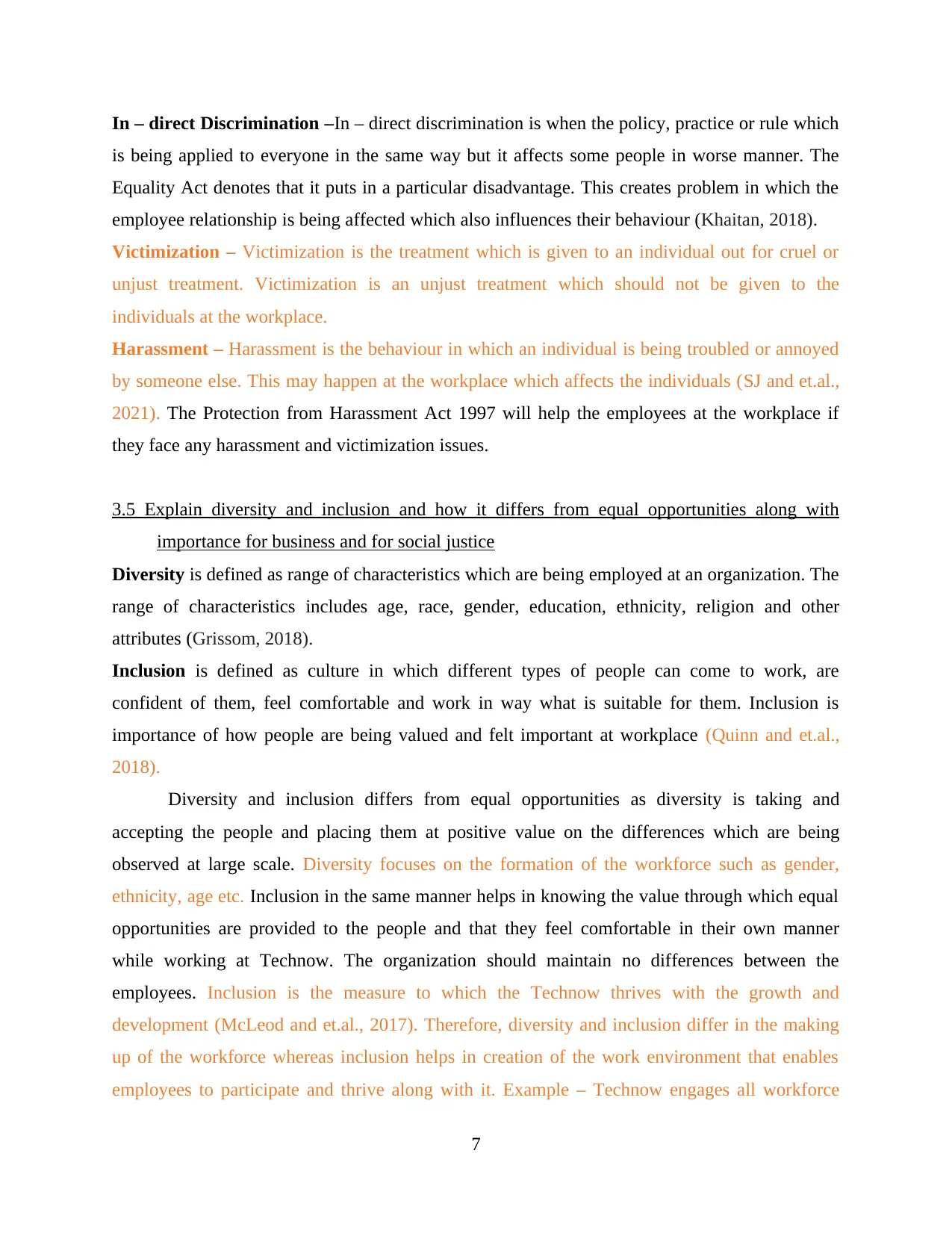
In – direct Discrimination –In – direct discrimination is when the policy, practice or rule which
is being applied to everyone in the same way but it affects some people in worse manner. The
Equality Act denotes that it puts in a particular disadvantage. This creates problem in which the
employee relationship is being affected which also influences their behaviour (Khaitan, 2018).
Victimization – Victimization is the treatment which is given to an individual out for cruel or
unjust treatment. Victimization is an unjust treatment which should not be given to the
individuals at the workplace.
Harassment – Harassment is the behaviour in which an individual is being troubled or annoyed
by someone else. This may happen at the workplace which affects the individuals (SJ and et.al.,
2021). The Protection from Harassment Act 1997 will help the employees at the workplace if
they face any harassment and victimization issues.
3.5 Explain diversity and inclusion and how it differs from equal opportunities along with
importance for business and for social justice
Diversity is defined as range of characteristics which are being employed at an organization. The
range of characteristics includes age, race, gender, education, ethnicity, religion and other
attributes (Grissom, 2018).
Inclusion is defined as culture in which different types of people can come to work, are
confident of them, feel comfortable and work in way what is suitable for them. Inclusion is
importance of how people are being valued and felt important at workplace (Quinn and et.al.,
2018).
Diversity and inclusion differs from equal opportunities as diversity is taking and
accepting the people and placing them at positive value on the differences which are being
observed at large scale. Diversity focuses on the formation of the workforce such as gender,
ethnicity, age etc. Inclusion in the same manner helps in knowing the value through which equal
opportunities are provided to the people and that they feel comfortable in their own manner
while working at Technow. The organization should maintain no differences between the
employees. Inclusion is the measure to which the Technow thrives with the growth and
development (McLeod and et.al., 2017). Therefore, diversity and inclusion differ in the making
up of the workforce whereas inclusion helps in creation of the work environment that enables
employees to participate and thrive along with it. Example – Technow engages all workforce
7
is being applied to everyone in the same way but it affects some people in worse manner. The
Equality Act denotes that it puts in a particular disadvantage. This creates problem in which the
employee relationship is being affected which also influences their behaviour (Khaitan, 2018).
Victimization – Victimization is the treatment which is given to an individual out for cruel or
unjust treatment. Victimization is an unjust treatment which should not be given to the
individuals at the workplace.
Harassment – Harassment is the behaviour in which an individual is being troubled or annoyed
by someone else. This may happen at the workplace which affects the individuals (SJ and et.al.,
2021). The Protection from Harassment Act 1997 will help the employees at the workplace if
they face any harassment and victimization issues.
3.5 Explain diversity and inclusion and how it differs from equal opportunities along with
importance for business and for social justice
Diversity is defined as range of characteristics which are being employed at an organization. The
range of characteristics includes age, race, gender, education, ethnicity, religion and other
attributes (Grissom, 2018).
Inclusion is defined as culture in which different types of people can come to work, are
confident of them, feel comfortable and work in way what is suitable for them. Inclusion is
importance of how people are being valued and felt important at workplace (Quinn and et.al.,
2018).
Diversity and inclusion differs from equal opportunities as diversity is taking and
accepting the people and placing them at positive value on the differences which are being
observed at large scale. Diversity focuses on the formation of the workforce such as gender,
ethnicity, age etc. Inclusion in the same manner helps in knowing the value through which equal
opportunities are provided to the people and that they feel comfortable in their own manner
while working at Technow. The organization should maintain no differences between the
employees. Inclusion is the measure to which the Technow thrives with the growth and
development (McLeod and et.al., 2017). Therefore, diversity and inclusion differ in the making
up of the workforce whereas inclusion helps in creation of the work environment that enables
employees to participate and thrive along with it. Example – Technow engages all workforce
7
Paraphrase This Document
Need a fresh take? Get an instant paraphrase of this document with our AI Paraphraser
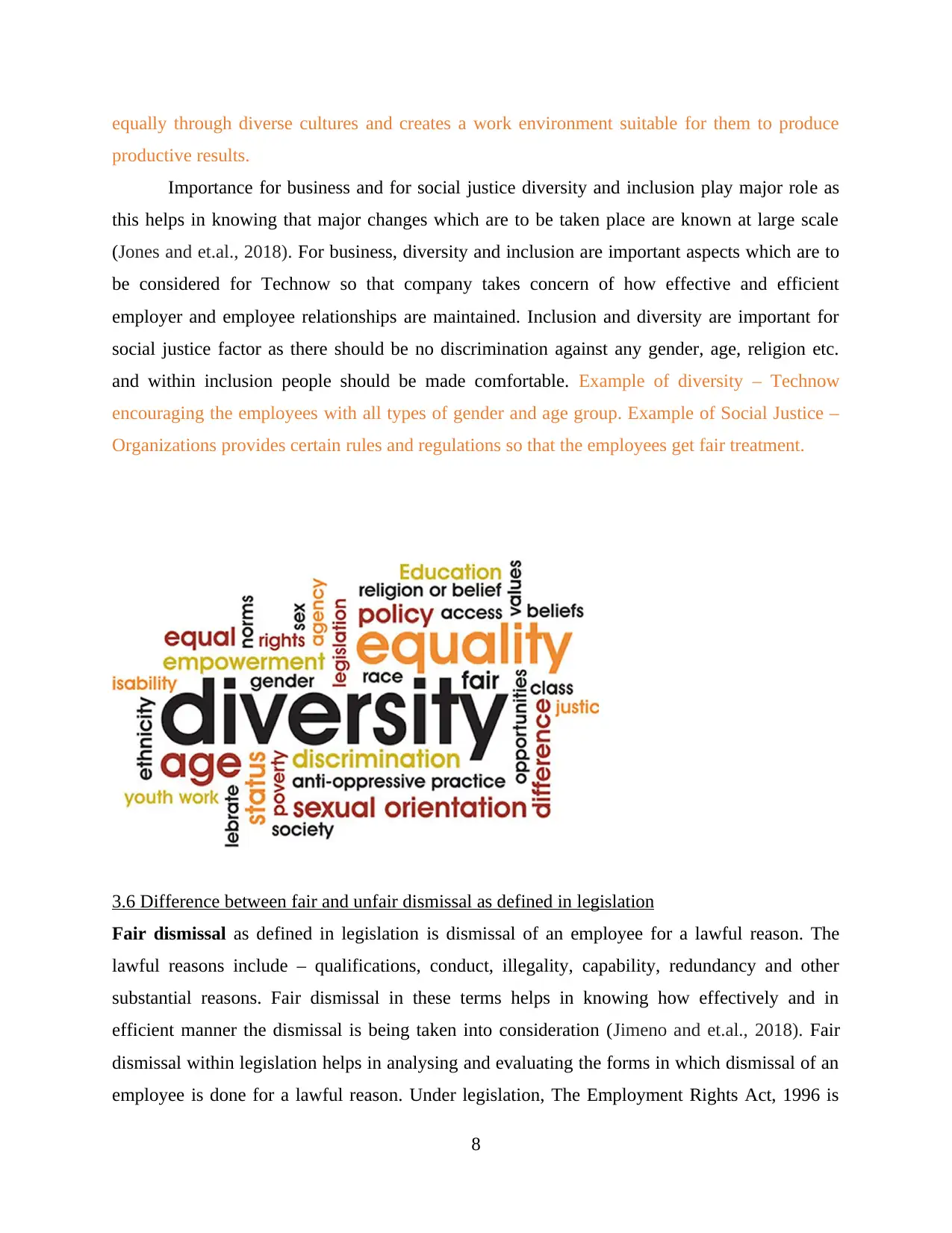
equally through diverse cultures and creates a work environment suitable for them to produce
productive results.
Importance for business and for social justice diversity and inclusion play major role as
this helps in knowing that major changes which are to be taken place are known at large scale
(Jones and et.al., 2018). For business, diversity and inclusion are important aspects which are to
be considered for Technow so that company takes concern of how effective and efficient
employer and employee relationships are maintained. Inclusion and diversity are important for
social justice factor as there should be no discrimination against any gender, age, religion etc.
and within inclusion people should be made comfortable. Example of diversity – Technow
encouraging the employees with all types of gender and age group. Example of Social Justice –
Organizations provides certain rules and regulations so that the employees get fair treatment.
3.6 Difference between fair and unfair dismissal as defined in legislation
Fair dismissal as defined in legislation is dismissal of an employee for a lawful reason. The
lawful reasons include – qualifications, conduct, illegality, capability, redundancy and other
substantial reasons. Fair dismissal in these terms helps in knowing how effectively and in
efficient manner the dismissal is being taken into consideration (Jimeno and et.al., 2018). Fair
dismissal within legislation helps in analysing and evaluating the forms in which dismissal of an
employee is done for a lawful reason. Under legislation, The Employment Rights Act, 1996 is
8
productive results.
Importance for business and for social justice diversity and inclusion play major role as
this helps in knowing that major changes which are to be taken place are known at large scale
(Jones and et.al., 2018). For business, diversity and inclusion are important aspects which are to
be considered for Technow so that company takes concern of how effective and efficient
employer and employee relationships are maintained. Inclusion and diversity are important for
social justice factor as there should be no discrimination against any gender, age, religion etc.
and within inclusion people should be made comfortable. Example of diversity – Technow
encouraging the employees with all types of gender and age group. Example of Social Justice –
Organizations provides certain rules and regulations so that the employees get fair treatment.
3.6 Difference between fair and unfair dismissal as defined in legislation
Fair dismissal as defined in legislation is dismissal of an employee for a lawful reason. The
lawful reasons include – qualifications, conduct, illegality, capability, redundancy and other
substantial reasons. Fair dismissal in these terms helps in knowing how effectively and in
efficient manner the dismissal is being taken into consideration (Jimeno and et.al., 2018). Fair
dismissal within legislation helps in analysing and evaluating the forms in which dismissal of an
employee is done for a lawful reason. Under legislation, The Employment Rights Act, 1996 is
8

known which helps in framing scale of fair dismissal for a lawful reason through an effective and
significant manner.
Unfair Dismissal as defined in legislation is when the employer within the organization
terminates the employee on unfair grounds which are indistinct, capricious and harsh or even
without any reason. Unfair dismissal under the legislation is the dismissal of the employee not on
fair and valid grounds (Pastory, 2019). Unfair Dismissal Act, 1977 under legislation helped in
knowing the aspects through which unfair means of employee termination is known and the fact
that how employer dismisses the position of employee within organization. This helps in
knowing the intentions of the employer which are being performed and the actions which
employer takes.
With the help of Case Study – The case study which is being taken is of the Technow and in
this the major aspect for which the company is initiating its major changes is that it is focusing
on the perspectives of how unfair dismissal is not created and this initiates that how the
employees are to be treated. Whether employees are being treated fairly or not. Meeting was
being conducted which helped in analyzing the basic aspects of how effective the changes can be
made for the unfair dismissal to not happen.
CONCLUSION
Thus, it is concluded from the above narrative that importance of work – life balance,
employee engagement, diversity and inclusion will take the form which helped in forming the
scale through which all the perspectives of what are the terms and how sportingly they comply to
relationships with employee and employer within Technow. Along with this, employee
discrimination, fair and unfair dismissal law under legislation was being framed and how they
impact the employee and the organization at large scale was known and evaluated. The main
thing which was also observed that how Technow can take the perspectives effectively and
efficiently.
9
significant manner.
Unfair Dismissal as defined in legislation is when the employer within the organization
terminates the employee on unfair grounds which are indistinct, capricious and harsh or even
without any reason. Unfair dismissal under the legislation is the dismissal of the employee not on
fair and valid grounds (Pastory, 2019). Unfair Dismissal Act, 1977 under legislation helped in
knowing the aspects through which unfair means of employee termination is known and the fact
that how employer dismisses the position of employee within organization. This helps in
knowing the intentions of the employer which are being performed and the actions which
employer takes.
With the help of Case Study – The case study which is being taken is of the Technow and in
this the major aspect for which the company is initiating its major changes is that it is focusing
on the perspectives of how unfair dismissal is not created and this initiates that how the
employees are to be treated. Whether employees are being treated fairly or not. Meeting was
being conducted which helped in analyzing the basic aspects of how effective the changes can be
made for the unfair dismissal to not happen.
CONCLUSION
Thus, it is concluded from the above narrative that importance of work – life balance,
employee engagement, diversity and inclusion will take the form which helped in forming the
scale through which all the perspectives of what are the terms and how sportingly they comply to
relationships with employee and employer within Technow. Along with this, employee
discrimination, fair and unfair dismissal law under legislation was being framed and how they
impact the employee and the organization at large scale was known and evaluated. The main
thing which was also observed that how Technow can take the perspectives effectively and
efficiently.
9
⊘ This is a preview!⊘
Do you want full access?
Subscribe today to unlock all pages.

Trusted by 1+ million students worldwide
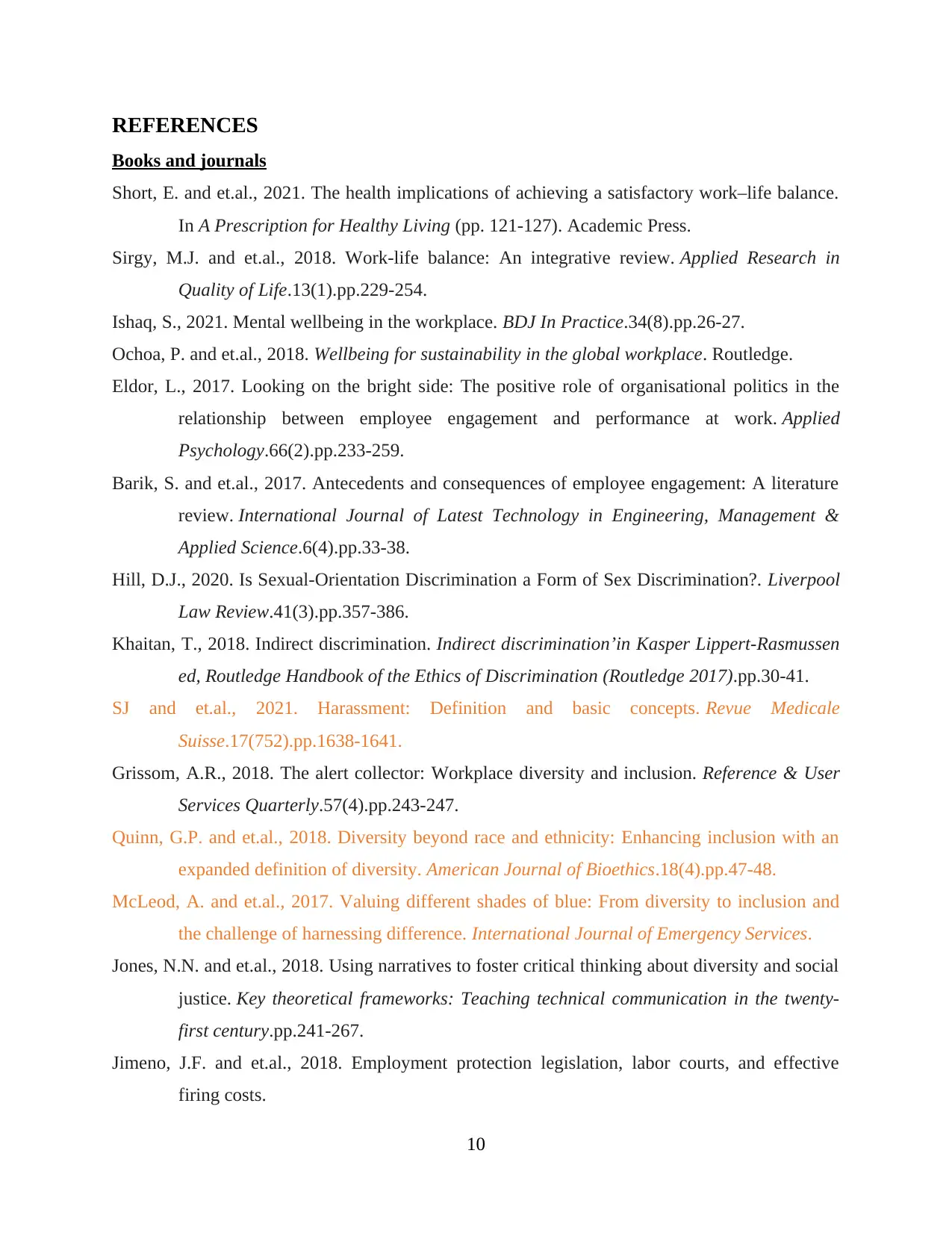
REFERENCES
Books and journals
Short, E. and et.al., 2021. The health implications of achieving a satisfactory work–life balance.
In A Prescription for Healthy Living (pp. 121-127). Academic Press.
Sirgy, M.J. and et.al., 2018. Work-life balance: An integrative review. Applied Research in
Quality of Life.13(1).pp.229-254.
Ishaq, S., 2021. Mental wellbeing in the workplace. BDJ In Practice.34(8).pp.26-27.
Ochoa, P. and et.al., 2018. Wellbeing for sustainability in the global workplace. Routledge.
Eldor, L., 2017. Looking on the bright side: The positive role of organisational politics in the
relationship between employee engagement and performance at work. Applied
Psychology.66(2).pp.233-259.
Barik, S. and et.al., 2017. Antecedents and consequences of employee engagement: A literature
review. International Journal of Latest Technology in Engineering, Management &
Applied Science.6(4).pp.33-38.
Hill, D.J., 2020. Is Sexual-Orientation Discrimination a Form of Sex Discrimination?. Liverpool
Law Review.41(3).pp.357-386.
Khaitan, T., 2018. Indirect discrimination. Indirect discrimination’in Kasper Lippert-Rasmussen
ed, Routledge Handbook of the Ethics of Discrimination (Routledge 2017).pp.30-41.
SJ and et.al., 2021. Harassment: Definition and basic concepts. Revue Medicale
Suisse.17(752).pp.1638-1641.
Grissom, A.R., 2018. The alert collector: Workplace diversity and inclusion. Reference & User
Services Quarterly.57(4).pp.243-247.
Quinn, G.P. and et.al., 2018. Diversity beyond race and ethnicity: Enhancing inclusion with an
expanded definition of diversity. American Journal of Bioethics.18(4).pp.47-48.
McLeod, A. and et.al., 2017. Valuing different shades of blue: From diversity to inclusion and
the challenge of harnessing difference. International Journal of Emergency Services.
Jones, N.N. and et.al., 2018. Using narratives to foster critical thinking about diversity and social
justice. Key theoretical frameworks: Teaching technical communication in the twenty-
first century.pp.241-267.
Jimeno, J.F. and et.al., 2018. Employment protection legislation, labor courts, and effective
firing costs.
10
Books and journals
Short, E. and et.al., 2021. The health implications of achieving a satisfactory work–life balance.
In A Prescription for Healthy Living (pp. 121-127). Academic Press.
Sirgy, M.J. and et.al., 2018. Work-life balance: An integrative review. Applied Research in
Quality of Life.13(1).pp.229-254.
Ishaq, S., 2021. Mental wellbeing in the workplace. BDJ In Practice.34(8).pp.26-27.
Ochoa, P. and et.al., 2018. Wellbeing for sustainability in the global workplace. Routledge.
Eldor, L., 2017. Looking on the bright side: The positive role of organisational politics in the
relationship between employee engagement and performance at work. Applied
Psychology.66(2).pp.233-259.
Barik, S. and et.al., 2017. Antecedents and consequences of employee engagement: A literature
review. International Journal of Latest Technology in Engineering, Management &
Applied Science.6(4).pp.33-38.
Hill, D.J., 2020. Is Sexual-Orientation Discrimination a Form of Sex Discrimination?. Liverpool
Law Review.41(3).pp.357-386.
Khaitan, T., 2018. Indirect discrimination. Indirect discrimination’in Kasper Lippert-Rasmussen
ed, Routledge Handbook of the Ethics of Discrimination (Routledge 2017).pp.30-41.
SJ and et.al., 2021. Harassment: Definition and basic concepts. Revue Medicale
Suisse.17(752).pp.1638-1641.
Grissom, A.R., 2018. The alert collector: Workplace diversity and inclusion. Reference & User
Services Quarterly.57(4).pp.243-247.
Quinn, G.P. and et.al., 2018. Diversity beyond race and ethnicity: Enhancing inclusion with an
expanded definition of diversity. American Journal of Bioethics.18(4).pp.47-48.
McLeod, A. and et.al., 2017. Valuing different shades of blue: From diversity to inclusion and
the challenge of harnessing difference. International Journal of Emergency Services.
Jones, N.N. and et.al., 2018. Using narratives to foster critical thinking about diversity and social
justice. Key theoretical frameworks: Teaching technical communication in the twenty-
first century.pp.241-267.
Jimeno, J.F. and et.al., 2018. Employment protection legislation, labor courts, and effective
firing costs.
10
Paraphrase This Document
Need a fresh take? Get an instant paraphrase of this document with our AI Paraphraser
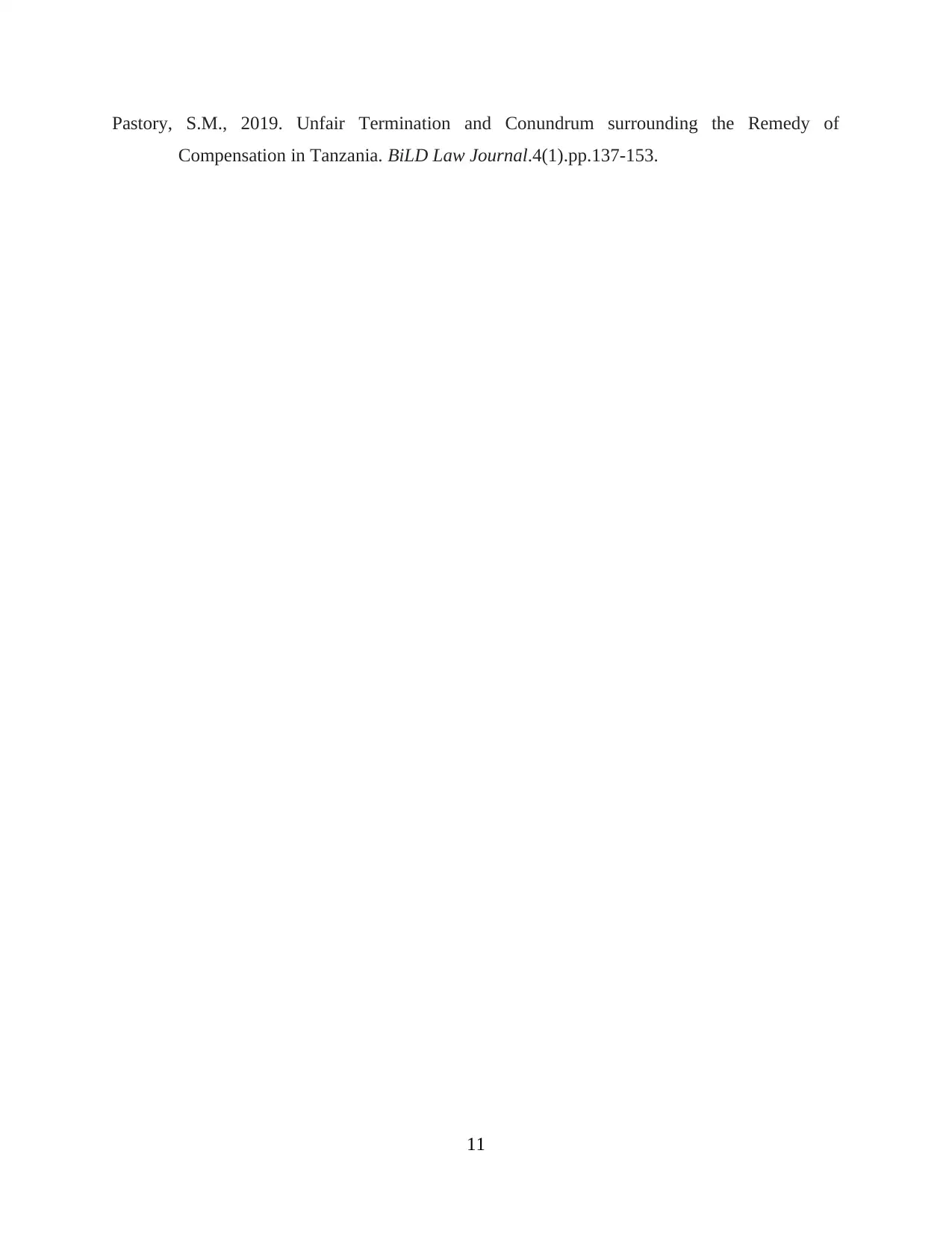
Pastory, S.M., 2019. Unfair Termination and Conundrum surrounding the Remedy of
Compensation in Tanzania. BiLD Law Journal.4(1).pp.137-153.
11
Compensation in Tanzania. BiLD Law Journal.4(1).pp.137-153.
11
1 out of 11
Related Documents
Your All-in-One AI-Powered Toolkit for Academic Success.
+13062052269
info@desklib.com
Available 24*7 on WhatsApp / Email
![[object Object]](/_next/static/media/star-bottom.7253800d.svg)
Unlock your academic potential
Copyright © 2020–2025 A2Z Services. All Rights Reserved. Developed and managed by ZUCOL.



